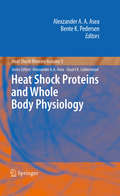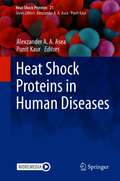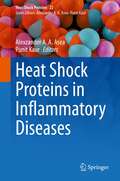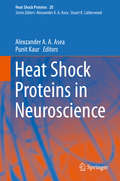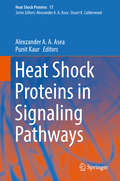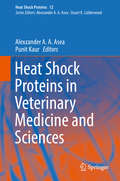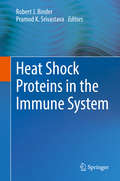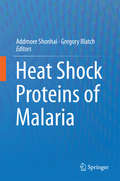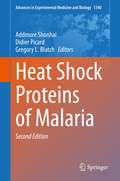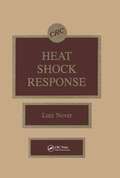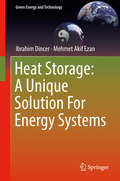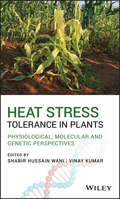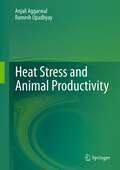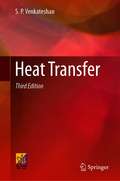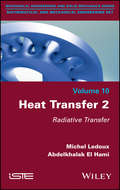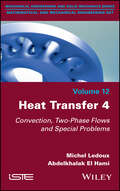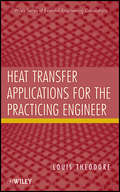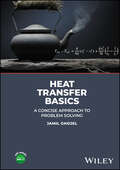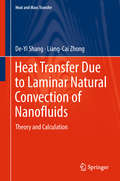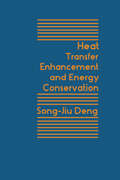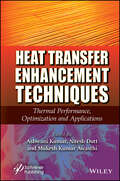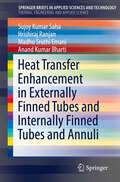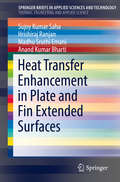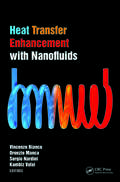- Table View
- List View
Heat Shock Proteins and Whole Body Physiology
by Alexzander A. Asea Bente K. PedersenHeat Shock Proteins and Whole Body Physiology is an exciting new book in the Heat Shock Proteins series which provides the most up-to-date review on novel mechanisms insights into the important role played by heat shock proteins in human physiology. Written by leaders in the field of heat shock protein exercise physiology, neuroscience and aging, the chapters systematically and in a step wise fashion takes the reader through the fascinating mechanisms by which heat shock proteins modulate human disease and pathophysiology and provides answers as to its biological significance to the host. Section I, introduces the readers to the role played by heat shock proteins in various diseases and disorders (Heat Shock Proteins and Disease). Section II, addresses the role heat shock proteins play in psychological disorders including post traumatic stress disorders and learning (Heat Shock Proteins and Psychological Stress). Section III, present a detailed review of the role played by heat shock proteins in exercise physiology (Heat Shock Proteins and Exercise Physiology). This book is a must read for heat shock protein researchers, graduate and postgraduate fellows in the field of Medicine in general and specialities in Excersie Physiology, Neuroscience, Immunology, Aging and Pathology.
Heat Shock Proteins in Human Diseases (Heat Shock Proteins #21)
by Alexzander A. A. Asea Punit KaurThe book Heat Shock Proteins in Cancer Therapeutics provides the most comprehensive review on contemporary knowledge on the role of HSP in various types of cancer therapeutics. Using an integrative approach, the contributors provide a synopsis of the most current updates on the state of HSP in cancer therapeutics.The heat shock response pathway is a highly conserved cellular process. Heat shock factors are a master transcriptional regulator responsible for expression of several important heat shock proteins, which can effectively protect critical client proteins from misfolding and degradation, thus maintaining intracellular integrity under stressed conditions. Recent studies have demonstrated the direct connections between heat shock response players and tumor cell survival, validating heat shock response players as novel molecular targets in anticancer treatment. Although many hurdles in clinical application still need to be effectively addressed, such as undesirable drug toxicity and off target effects; narrow therapeutic window; poor PK/PD profiles, etc. Recent reports on synergistic drug combination, advanced prodrug design, smart nanoparticle packaging, and RNA aptamer selection offer promising solutions to overcome these challenges. Future advancements in this fast-growing area can potentially lead to the next generation of cancer therapeutics.Key basic and clinical research laboratories from major universities, academic medical hospitals, biotechnology and pharmaceutical laboratories around the world have contributed chapters that review present research activity and importantly project the field into the future. The book is a must read for graduate students. medical students, basic science researchers and postdoctoral scholars in the fields of Cancer Biology, Oncology, Translational Medicine, Clinical Research, Biotechnology, Cell & Molecular Medicine, Pharmaceutical Scientists and Researchers involved in Drug Discovery.
Heat Shock Proteins in Inflammatory Diseases (Heat Shock Proteins #22)
by Alexzander A. A. Asea Punit KaurThe book Heat Shock Proteins in Inflammatory Diseases provides the most comprehensive highlight and insight of the expression, function and therapeutic activity of Heat Shock Proteins in inflammatory diseases including sepsis, psoriasis, neurodegenerative diseases, cancers, viral infection and autoimmune rheumatic diseases. Using an integrative approach, the contributors provide a synopsis of the most current updates on the state of HSP in inflammatory diseases.Key basic and clinical research laboratories from major universities, academic medical hospitals, biotechnology and pharmaceutical laboratories around the world have contributed chapters that review present research activity and importantly project the field into the future. The book is a must read for graduate students. medical students, basic science researchers and postdoctoral scholars in the fields of Cancer Biology, Oncology, Translational Medicine, Clinical Research, Biotechnology, Cell & Molecular Medicine, Pharmaceutical Scientists and Researchers involved in Drug Discovery.
Heat Shock Proteins in Neuroscience (Heat Shock Proteins #20)
by Alexzander A. A. Asea Punit KaurThe book Heat Shock Proteins in Neuroscience provides the most comprehensive review on contemporary knowledge on the role of HSP in signaling pathways relevant to a number of diseases. Using an integrative approach, the contributors provide a synopsis of novel mechanisms, signal transduction pathways. To enhance the ease of reading and comprehension, this book has been subdivided into various section including; Section I, reviews current progress on our understanding of Neurological Aspects of HSP; Section II, focuses on Aspects of HSP in Neurodegenerative Diseases and Disorders, Section III, emphasizes the importance of HSP in Multiple Sclerosis; Section IV, reviews critical Aspects of HSP in Alzheimer’s Disease and Section V, gives a comprehensive update of the Development of HSP-Based Therapies for Neurological Disorders. Key basic and clinical research laboratories from major universities, academic medical hospitals, biotechnology and pharmaceutical laboratories around the world have contributed chapters that review present research activity and importantly project the field into the future. The book is a must read for starters and professionals in the fields of Neurology and Neurosciences, Translational Medicine, Clinical Research, Human Physiology, Biotechnology, Cell & Molecular Medicine, Pharmaceutical Scientists and Researchers involved in Drug Discovery.
Heat Shock Proteins in Signaling Pathways (Heat Shock Proteins #17)
by Alexzander A. A. Asea Punit KaurSignaling pathways is a comprehensive mechanism by which all cellular organisms communicate internally and externally with their microenvironment. This is a highly complex and exact process. Errors in signaling pathways and in the processing of cellular information are known to be responsible for the majority of diseases including cancer, inflammatory and neurological disorders. Knowledge gained from the better understanding of signaling pathways will help in elucidating disease processes and will assist in development and design of novel targeted treatment therapies to combat human diseases and disorders. Heat shock proteins (HSP) are uniquely involved in a number of critical signaling pathways. Key basic and clinical research laboratories from major universities, academic medical hospitals, biotechnology and pharmaceutical laboratories around the world have contributed chapters that review present research activity and importantly project the field into the future. The book is a must read for graduate students. medical students, basic science researchers and postdoctoral scholars in the fields of Translational Medicine, Clinical Research, Human Physiology, Biotechnology, Cell & Molecular Medicine, Pharmaceutical Scientists and Researchers involved in Drug Discovery.
Heat Shock Proteins in Veterinary Medicine and Sciences: Published under the Sponsorship of the Association for Institutional Research (AIR) and the Association for the Study of Higher Education (ASHE) (Heat Shock Proteins #12)
by Alexzander A. A. Asea Punit KaurThis books provides up-to-date reviews on current advances of the role of HSP in veterinary medicine and research. Key basic and clinical research laboratories from major universities, veterinary hospitals and pharmaceutical companies around the world have contributed chapters that review present research activity and importantly project this field into the future. For easy readability, the book is sub divided into sections on HSP in the following aspects of Veterinary Medicine, including, I - Domestic Animals, II - Poultry, III - Aquatic and IV - Parasites. The book is a must read for heat shock protein researchers in general and specifically those involved in clinical and research in veterinary medicine.
Heat Shock Proteins in the Immune System
by Robert J. Binder Pramod K. SrivastavaExperts from around the world review the current field of the immunobiology of heat shock proteins, and provide a comprehensive account of how these molecules are spearheading efforts in the understanding of various pathways of the immune system. This one-stop resource contains numerous images to both help illustrate the research on heat shock proteins, and better clarify the field for the non-expert. Heat shock proteins (HSPs) were discovered in 1962 and were quickly recognized for their role in protecting cells from stress. Twenty years later, the immunogenicity of a select few HSPs was described, and for the past 30 years, these findings have been applied to numerous branches of immunology, including tumor immunology and immunosurveillance, immunotherapy, etiology of autoimmunity, immunotherapy of infectious diseases, and expression of innate receptors. While HSPs can be used to manipulate immune responses by exogenous administration, they appear to be involved in initiation of de novo immune responses to cancer and likely in the maintenance of immune homeostasis.
Heat Shock Proteins of Malaria
by Addmore Shonhai Gregory L. BlatchThis book describes the role of heat shock proteins in the life cycle of malaria parasites. The work includes a general introduction on the structural and functional features of heat shock proteins. The main focus is on the role of heat shock protein families from Plasmodium falciparum, their role in protein folding and in the development of malaria pathology. The functions of individual families of heat shock proteins from plasmodium species and their cooperation in functional networks is described. Subcellular and extracellular organelles such as the apicoplast and the Maurer's Clefts which are associated with plasmodium species, are discussed in detail. The role of heat shock proteins in the development and function of these organelles structures are highlighted. Although conceding that heat shock proteins may not be ideal antimalarial drug targets, prospects of targeting heat shock proteins in antimalarial drug discovery either directly and/or in combination therapies are explored.
Heat Shock Proteins of Malaria (Advances in Experimental Medicine and Biology #1340)
by Addmore Shonhai Gregory L. Blatch Didier PicardThis new edition describes the role of heat shock proteins in the life cycle of malaria parasites, particularly in the context of intracellular parasite stages. Thoroughly revised, this work provides a general introduction to the structural and functional features of heat shock proteins with a special focus on their role as molecular chaperones in ensuring protein quality control. The emphasis is on the heat shock protein families from Plasmodium falciparum, and their role in proteostasis and the development of malaria pathology. Moreover, the authors explore the latest prospects of targeting heat shock proteins in antimalarial drug discovery either directly or in combination therapies.Readers will experience a functional analysis of the individual families of heat shock proteins and their cooperation in functional networks, including both the parasite-resident proteome and the exportome released into host cells during intracellular stages. Subcellular and extracellular organelles such as the apicoplast and the Maurer’s Clefts associated with Plasmodium species are discussed in detail. The book highlights the role of heat shock proteins in the development and function of these structures. Biochemical expertise and the inclusion of novel therapeutic solutions make this collection a unique reference for experts in heat shock protein research, parasitology and infectious diseases, cell stress, molecular biology and drug discovery. Not least, advances in malaria control will contribute to ending epidemics and ensuring healthy lives in line with the UN Sustainable Development Goals.
Heat Shock Response
by Lutz NoverThis book focuses on heat shock response-an active yet transient reprogramming of cellular activities to the needs of a stress protection mechanism designed to minimize heat damage and to optimize restoration of normal cellular activities after the stress period. This work places major emphasis on the structure and possible cellular functions of heat shock proteins as well as the analysis of heat shock protein-coding genes by transfection into homologous and heterologous expression systems. It also discusses heat shock effects on all levels of gene expression, on cell ultrastructure, and metabolic activities. This unique text is a must for all those who are involved with genetics, nucleic acids research, and cancer research.
Heat Storage: A Unique Solution For Energy Systems (Green Energy and Technology)
by Ibrahim Dincer Mehmet Akif EzanThis book covers emerging energy storage technologies and material characterization methods along with various systems and applications in building, power generation systems and thermal management. The authors present options available for reducing the net energy consumption for heating/cooling, improving the thermal properties of the phase change materials and optimization methods for heat storage embedded multi-generation systems. An in-depth discussion on the natural convection-driven phase change is included. The book also discusses main energy storage options for thermal management practices in photovoltaics and phase change material applications that aim passive thermal control. This book will appeal to researchers and professionals in the fields of mechanical engineering, chemical engineering, electrical engineering, renewable energy, and thermodynamics. It can also be used as an ancillary text in upper-level undergraduate courses and graduate courses in these fields.
Heat Stress Tolerance in Plants: Physiological, Molecular and Genetic Perspectives
by Shabir HussainWaniDemystifies the genetic, biochemical, physiological, and molecular mechanisms underlying heat stress tolerance in plants Heat stress—when high temperatures cause irreversible damage to plant function or development—severely impairs the growth and yield of agriculturally important crops. As the global population mounts and temperatures continue to rise, it is crucial to understand the biochemical, physiological, and molecular mechanisms of thermotolerance to develop ‘climate-smart’ crops. Heat Stress Tolerance in Plants provides a holistic, cross-disciplinary survey of the latest science in this important field. Presenting contributions from an international team of plant scientists and researchers, this text examines heat stress, its impact on crop plants, and various mechanisms to modulate tolerance levels. Topics include recent advances in molecular genetic approaches to increasing heat tolerance, the potential role of biochemical and molecular markers in screening germplasm for thermotolerance, and the use of next-generation sequencing to unravel the novel genes associated with defense and metabolite pathways. This insightful book: Places contemporary research on heat stress in plants within the context of global climate change and population growth Includes diverse analyses from physiological, biochemical, molecular, and genetic perspectives Explores various approaches to increasing heat tolerance in crops of high commercial value, such as cotton Discusses the applications of plant genomics in the development of thermotolerant ‘designer crops’ An important contribution to the field, Heat Stress Tolerance in Plants is an invaluable resource for scientists, academics, students, and researchers working in fields of pulse crop biochemistry, physiology, genetics, breeding, and biotechnology.
Heat Stress and Animal Productivity
by Anjali Aggarwal Ramesh UpadhyayDr. Anjali Aggarwal is working as a Senior Scientist at National Dairy Research Institute, Karnal (India). She holds a PhD degree in Animal Physiology and is involved in research and teaching at post-graduate level. Her area of research work is stress and environmental physiology. She has more than 50 publications, two technical bulletins, four manuals and many book chapters to her credit. She has successfully guided many post-graduate and PhD students. Her major research accomplishments are on microclimatic modification for alleviation of heat and cold stress, mist and fan cooling systems for cows and buffaloes, and use of wallowing tank in buffaloes. Her work involves the use of technology of supplementing micronutrients during dry period and early lactation to crossbred and indigenous cows for alleviating metabolic and oxidative stress and improved health and productivity. Studies are also done in her lab on partitioning of heat loss from skin and pulmonary system of cattle and buffaloes as a result of exercise or exposure to heat stress. Dr. R.C. Upadhyay is working as Head, Dairy Cattle Physiology Division at National Dairy Research Institute, Karnal (India). He graduated in Veterinary Sciences and obtained his PhD degree in Animal Physiology. His area of recent research is climate change, stress, and environmental physiology. His major research accomplishment is on climate change impact assessment of milk production and growth in livestock. His work also involves studying methane conversion and emission factors for Indian livestock and use of IPCC methodology of methane inventory of Indian livestock. Heat shock protein-70 expression studies in cattle and buffaloes are also done in his lab. Draught animal power evaluation, fatigue assessment, work-rest cycle and work limiting factors form the highlights of his work. Studies on partitioning of heat loss from skin and pulmonary system of cattle and buffaloes and electrocardiographic studies in cattle, buffalo, sheep and goat are also undertaken in his lab. He has more than 75 research papers, four books and several book chapters to his credit. Technologies developed and research done by him include methodology of methane measurement: open and closed circuit for cattle and buffaloes; inventory of methane emission from livestock using IPCC methodology; livestock stress index: thermal stress measurement based on physiological functions; and draught power evaluation system and large animal treadmill system. He received training in Radio-nuclides in medicine at Australian School of Nuclear Technology, Lucas heights, NSW, Australia in 1985 and Use of radioisotopes in cardiovascular investigations at CSIRO, Prospect, NSW, Australia, during 1985-86. He has guided several post-graduate and PhD students. He is recipient of Hari Om Ashram Award-1990 (ICAR) for outstanding research in animal sciences.
Heat Transfer
by Gregory Nellis Sanford KleinThis textbook provides engineers with the capability, tools and confidence to solve real-world heat transfer problems. It includes many advanced topics, such as Bessel functions, Laplace transforms, separation of variables, Duhamel's theorem and complex combination, as well as high order explicit and implicit numerical integration algorithms. These analytical and numerical solution methods are applied to topics not considered in most textbooks. Examples include heat exchangers involving fluids with varying specific heats or phase changes; heat exchangers in which axial conduction is a concern; and regenerators. Derivations of important results are presented completely, without skipping steps, which reduces student frustration and improves readability and retention. The examples are not trivial 'textbook' exercises; they are rather complex and timely real-world problems that are inherently interesting. This book integrates the computational software packages Maple, MATLAB, FEHT and Engineering Equation Solver (EES) directly with the heat transfer material.
Heat Transfer
by S.P. VenkateshanThe book covers various topics of heat transfer. It explains and analyzes several techniques and modes of heat transfer such as conduction in stationary media, convection in moving media and also by radiation. It is primarily a text book useful for undergraduate and postgraduate students. The book should also interest practicing engineers who wish to refresh their knowledge in the field. The book presents the various topics in a systematic way starting from first principles. The topics are developed to a fairly advanced level towards the end of each chapter. Several worked examples illustrate the engineering applications of the basic modeling tools developed in the text. The exercises at the end of the book are arranged chapter wise and challenge the reader to tackle typical real-life problems in heat transfer. This book will be of potential use for students of mechanical engineering, chemical engineering and metallurgy in most engineering colleges.
Heat Transfer 2: Radiative Transfer
by Michel Ledoux Abdelkhalak El HamiHeat is a branch of thermodynamics that occupies a unique position due to its involvement in the field of practice. Being linked to the management, transport and exchange of energy in thermal form, it impacts all aspects of human life and activity. Heat transfers are, by nature, classified as conduction, convection (which inserts conduction into fluid mechanics) and radiation. The importance of these three transfer methods has resulted – justifiably – in a separate volume being afforded to each of them. This second volume is dedicated to radiation. After recalling photometry, the calculation of luminance is addressed using the theory of the black body and associated laws: Stefan, Wien. The reciprocal radiation of two surfaces in total influence is discussed extensively, and the case of finished surfaces is also considered. Heat Transfer 2 combines a basic approach with a deeper understanding of the discipline and will therefore appeal to a wide audience, from technician to engineer, from doctoral student to teacher-researcher.
Heat Transfer 4: Convection, Two-Phase Flows and Special Problems
by Abdelkhalak El Hami Michel LedouxHeat Transfer 4: Convection, Two-Phase Flows and Special Problems
Heat Transfer Applications for the Practicing Engineer
by Louis TheodoreThis book serves as a training tool for individuals in industry and academia involved with heat transfer applications. Although the literature is inundated with texts emphasizing theory and theoretical derivations, the goal of this book is to present the subject of heat transfer from a strictly pragmatic point of view. The book is divided into four Parts: Introduction, Principles, Equipment Design Procedures and Applications, and ABET-related Topics. The first Part provides a series of chapters concerned with introductory topics that are required when solving most engineering problems, including those in heat transfer. The second Part of the book is concerned with heat transfer principles. Topics that receive treatment include Steady-state Heat Conduction, Unsteady-state Heat Conduction, Forced Convection, Free Convection, Radiation, Boiling and Condensation, and Cryogenics. Part three (considered the heart of the book) addresses heat transfer equipment design procedures and applications. In addition to providing a detailed treatment of the various types of heat exchangers, this part also examines the impact of entropy calculations on exchanger design, and operation, maintenance and inspection (OM&I), plus refractory and insulation effects. The concluding Part of the text examines ABET (Accreditation Board for Engineering and Technology) related topics of concern, including economies and finance, numerical methods, open-ended problems, ethics, environmental management, and safety and accident management.
Heat Transfer Basics: A Concise Approach to Problem Solving
by Jamil GhojelHEAT TRANSFER BASICS Concise introduction to heat transfer, with a focus on worked example problems to aid in reader comprehension and student learning Heat Transfer Basics covers the essential topics of heat transfer in a focused manner, starting with an introduction to heat transfer that explains its relationship to thermodynamics and fluid mechanics and continuing on to key topics such as free convection, boiling and condensation, radiation, heat exchangers, and more, for an accessible and reader-friendly yet comprehensive treatment of the subject. Each chapter features multiple worked out example problems, including derivations of key governing equations and comparisons of worked solutions with computer modeled results, which helps students become familiar with the types of problems they will encounter in the field. Throughout the book, figures and diagrams liberally illustrate the concepts discussed, and practice problems allow students to test their understanding of the content. The text is accompanied by an online instructor’s manual. Heat Transfer Basics includes information on: One-dimensional, steady-state conduction, covering the plane wall, the composite wall, solid and hollow cylinders and sphere, conduction with and without internal energy generation, and conduction with constant and temperature-dependent thermal conductivity Heat transfer from extended surfaces, fins of uniform and variable cross-sectional area, fin performance, and overall fin efficiency Transient conduction, covering general lumped capacitance solution method, one- and multi-dimensional transient conduction, and the finite-difference method for solving transient problems Free and forced convection, covering hydrodynamic and thermal considerations, the energy balance, and thermal analysis and convection correlations More advanced than introductory textbooks yet not as overwhelming as textbooks targeted at specialists, Heat Transfer Basics is ideal for students in introductory and advanced heat transfer courses who do not intend to specialize in heat transfer, and is a helpful reference for advanced students and practicing engineers.
Heat Transfer Due to Laminar Natural Convection of Nanofluids: Theory And Calculation (Heat And Mass Transfer Ser.)
by De-Yi Shang Liang-Cai ZhongThis book presents a theoretical study of heat transfer due to laminar natural convection of nanofluids, using Al2O3-water nanofluid as an example. An innovative method of similarity transformation of velocity fields on laminar boundary layers is applied for the development of a mathematical governing model of natural convection with actual nanofluids, and a novel model of the nanofluid's variable thermophysical properties is derived by a mathematical analysis based on the developed model of variable physical properties of fluids combined with the model of the nanofluid's thermal conductivity and viscosity. Based on these, the physical property factors of nanofluids are produced, which leads to a simultaneous solution for deep investigations of hydrodynamics and heat transfer of nanofluid's natural convection.The book also proposes novel predictive formulae for the evaluation of heat transfer of Al2O3-water nanofluid’s natural convection. The formulae have reliable theoretical and practical value because they are developed by rigorous theoretical analysis of heat transfer combined with full consideration of the effects of the temperature-dependent physical properties of nanofluids and the nanoparticle shape factor and concentration, as well as variations of fluid boundary temperatures. The conversion factors proposed help to turn the heat transfer coefficient and rate of fluid natural convection into those of nanofluid natural convection. Furthermore, several calculation examples are provided to demonstrate the heat transfer application of the proposed predictive formulae.
Heat Transfer Enhancement And Energy Conservation
by Songshjiu DengHeat transfer is close connected to the better utilization of thermal energy. This book provides an international perspective on the status of heat transfer enhancement and energy conservation research, development, and applications. It contains scientific papers from countries and areas including Bahrain, Canada, China, France, the Federal Republic of Germany, Hong Kong, Italy, India, Japan, New Zealand, Poland, the United Kingdom, the United States of America, and Yugoslavia. It is a valuable reference for anyone interested in heat transfer enhancement and energy conservation.
Heat Transfer Enhancement Techniques: Thermal Performance, Optimization and Applications
by Ashwani Kumar Mukesh Kumar Awasthi Nitesh DuttThis comprehensive guide explores the latest heat transfer enhancement techniques and provides the knowledge and insights required to tackle present and future challenges associated with heat dissipation, making it an essential resource for researchers, engineers, and professionals in the field. In today’s rapidly evolving world, where technological advancements are driving industries forward, the need for innovative solutions for heat transfer and dissipation challenges is becoming increasingly critical. This book serves as a comprehensive guide that explores the latest heat transfer enhancement techniques and their potential to inspire the development of new devices and technologies. By delving into this subject matter, the book aims to empower researchers, engineers, and professionals in the field with the knowledge and insights required to tackle the present and future challenges associated with heat dissipation. It provides a roadmap for pushing the boundaries of traditional thinking and fostering innovation in the field. Heat Transfer Enhancement Techniques: Thermal Performance, Optimization and Applications will be helpful to readers in presenting the basic and advanced technological developments of heat transfer enhancement techniques. Each chapter will cover a specific problem with future scope to further extend this research. This book contains new methodologies, models, techniques, and applications, as well as fundamental knowledge of heat transfer techniques.
Heat Transfer Enhancement in Externally Finned Tubes and Internally Finned Tubes and Annuli (SpringerBriefs in Applied Sciences and Technology)
by Sujoy Kumar Saha Hrishiraj Ranjan Madhu Sruthi Emani Anand Kumar BhartiThis Brief deals with externally finned tubes, their geometric parameters, Reynolds number, dimensionless variables, friction factor, plain plate fins on round tubes, the effect of fin spacing, correlations, pain individually finned tubes, circular fins with staggered tubes, low integral fin tubes, wavy fin, enhanced plate fin geometries with round tubes, Offset Strip Fins, convex louver fins, louvered fin, perforated fin, mesh fin, vortex generator, enhanced circular fin geometries, spine or segmented fin, wire loop fin, flat extruded tubes with internal membranes, plate and fin automotive radiators, performance comparison, numerical simulation, advanced fin geometries, hydrophilic coatings, internally finned tubes and annuli, spirally fluted and indented tube, advanced internal fin geometries, and finned annuli. The book is ideal for professionals and researchers dealing with thermal management in devices.
Heat Transfer Enhancement in Plate and Fin Extended Surfaces (SpringerBriefs in Applied Sciences and Technology)
by Sujoy Kumar Saha Hrishiraj Ranjan Madhu Sruthi Emani Anand Kumar BhartiThis Brief deals with heat transfer and friction in plate and fin extended heat transfer enhancement surfaces. It examines Offset-Strip Fin (OSF), Enhancement Principle, Analytically Based Models for j and f vs. Re, Transition from Laminar to Turbulent Region, Correlations for j and f vs. Re, Use of OSF with Liquids, Effect of Percent Fin Offset, Effect of Burred Edges, Louver fin, heat transfer and friction correlations, flow structure in the louver fin array, analytical model for heat transfer and friction, convex louver fin, wavy fin, 3D corrugated fin, perforated fin, pin fins and wire mesh, types of vortex generators, metal foam fin, plain fin, packings, numerical simulation of various types of fins.
Heat Transfer Enhancement with Nanofluids
by Oronzio Manca Kambiz Vafai Vincenzo Bianco Sergio NardiniNanofluids are gaining the attention of scientists and researchers around the world. This new category of heat transfer medium improves the thermal conductivity of fluid by suspending small solid particles within it and offers the possibility of increased heat transfer in a variety of applications. Bringing together expert contributions from
